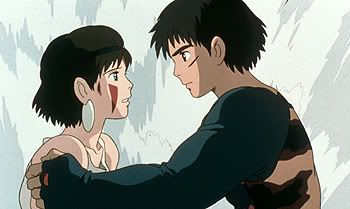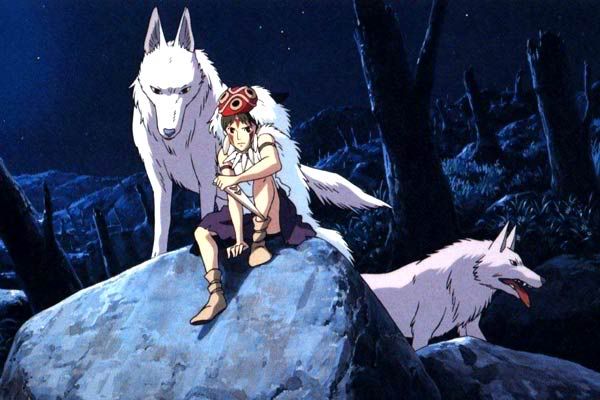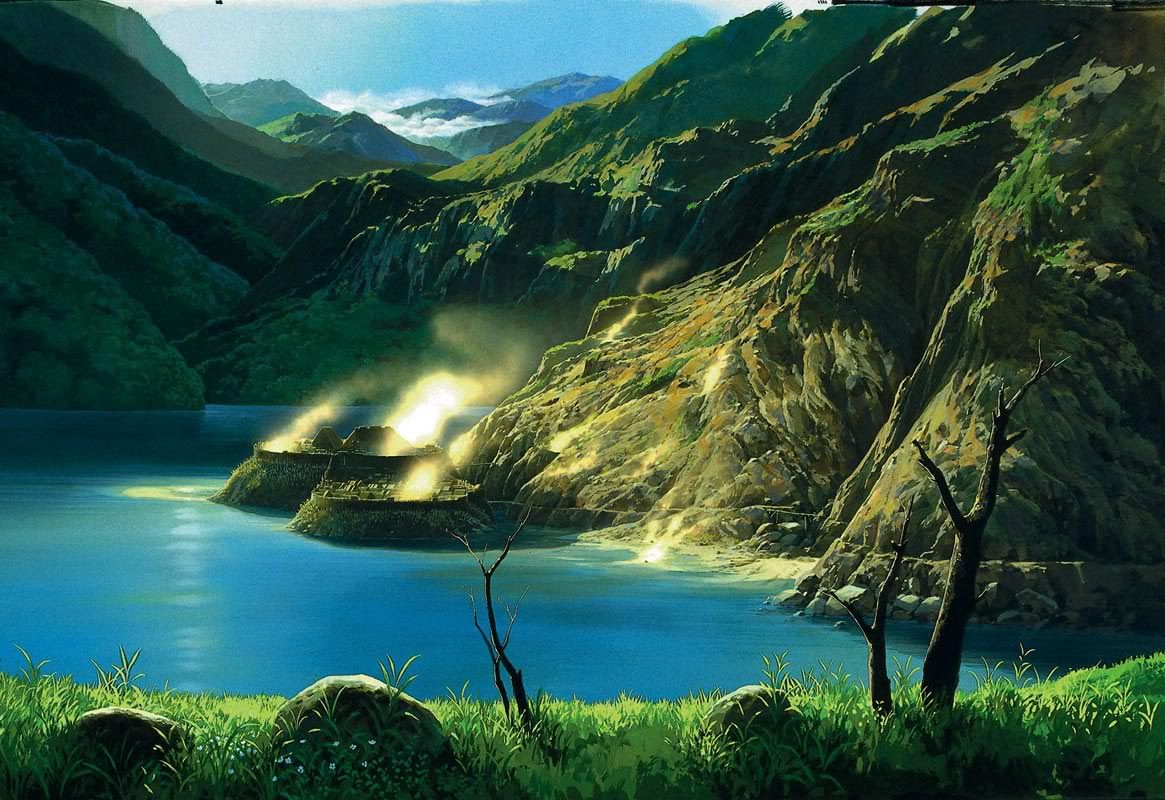Last night I watched Princess Mononoke again. Princess Mononoke is by Studio Ghibli, which I will be exploring a lot of in this blog. Hayao Miyazaki is the driving force behind Studio Ghibli. Isao Tahkahata and Goro Miyazaki are also large people within Studio Ghibli. Studio Ghibli explores environmental issues in nearly all of their films. Environmentalism and how humans interact with nature are all a part of the anime experience.
SUMMARY:

Princess Mononoke is about a young prince of the Emishi people by the name of Ashitaka. He is the last prince, as the Emishi people were wiped out by the emperor years ago. They are a very old culture, and still do things the traditional way. In the beginning, a boar god who has been infected by a poisonous ball of iron he acquired from the humans of the west attacks the Emishi village. Ashitaka manages to kill the boar god, but not before being infected by the beast. This curse is shown by mottled, purple colored skin. The curse will tear his soul apart and then kill him. Ashitaka decides to go out and see if he can stop the evil that infected the boar god and himself, by seeing "with eyes unclouded by hate". After he travels to the west he encounters an animalistic human named San who believes she is a wolf. She was raised by the wolf god, Moro, and hates the humans who are tearing down her forest. Two other characters also appear who are relevant to the plot. Lady Eboshi, mistress of Iron town, and Jigo. Jigo is working for the emperor, who offers anyone who can help him live forever a mountain of gold. Jigo wishes to kill the forest god and bring back his head to the emperor for gold. Lady Eboshi runs Iron Town, a town that stays true to its name and creates iron. She wishes for a mass of wealth, and has introduced guns and flamethrowers into a society that was previously using swords and bow and arrows. She doesn't really wish to kill the forest god, but she DOES want to destroy the forest in order to create more iron. The wolves and boars are against Lady Eboshi and attack her whenever possible. Ashitaka isn't really on anyone’s side but his own. He wishes for the forest and the humans to live in peace.
CHARACTER ANALYSIS:

The character I would really like to take a look at here, more than anyone else, is Lady Eboshi. To me, she is the more interesting of the characters in the movie. Lady Eboshi runs Iron Town, and it seems like she almost wants to take over the world, but she has good and bad intentions. It’s really up to the viewers to decide whether or not she is in the wrong. Lady Eboshi welcomes women who come from bad or hard times. She also helps and shelters lepers. The thing is, Lady Eboshi also wants to clear cut an entire forest all for her own personal gains. She wants to be rich off of iron. She helps the lepers, but in return they create new and better guns and flamethrowers for Lady Eboshi. The women Lady Eboshi takes in become her warriors who love her so much that they will kill anyone or anything she directs them towards without thinking about it first. This is seen especially when one of the women shoots Ashitaka, when previously they had been enjoying his company and welcomed him. This was only because Ashitaka stunned Lady Eboshi, and left with the human wolf. Lady Eboshi also states that she does not wish to kill the forest god, but she does want to kill the forest itself. She is the character that you have to think about the most. Is she mostly good or mostly bad?
ENVIORNMENTAL CONCERNS:
There are several different environmental concerns portrayed within this movie. The most obvious is clear cutting. Lady Eboshi is all for clear cutting, but that would kill the forest. Humans depend upon the forest for many reasons. The plants there create air for us to breath. We discover new ways to help humans all the time with plants and animals, but if we cut and destroy it all, we will never know what we could accomplish. The soil is also ruined by clear cutting. Habitats of animals, in this movie specifically boars and wolves, are destroyed. The forest in this movie has a forest god. When Lady Eboshi kills the forest god, the forest and everything in it dies. It turns brown and ugly, and it even kills most of the humans there as well. This is a good representation of what could happen if humans continue to clear cut and kill the land. It will come back on us, and kill us too. Humans depend upon the environment, but instead of helping to preserve it, the majority of us are ruining it. The lovable Kodama, or forest spirits, all die by the human hand. This can also be classified as the exploitation of natural resources.
Pollution is another, abliet lesser concern. When Ashitaka first comes across Iron Town, it is a large brown stain upon the once beautiful land. Smoke is shown coming from the town, polluting the air. The ground is brown and hard, not good for much of anything. Water sources would also be polluted to the extent that humans or animals can no longer drink from it.

If humans work together to right the wrongs we have done, we can be saved. This is what happens at the end of the movie. The head of the forest god is returned to it, and even though the forest god can no longer walk the earth, the forest becomes grown and pretty again. Flowers spring up, and the land becomes green instead of the deathly brown and black it had been from killing the forest God. We can only accomplish this, however, if humans work together to preserve what forest land we have left. In the US today, only 4% of our original forests remain.
The problem here is, humans can't even respect themselves, so is will be nearly impossible for them to respect the forest and the animals within it. This is shown the most when Jigo and Lady Eboshi go to battle the boars. Jigo puts Lady Eboshi's men on the front line to lure the boars out of the forest, but they don't even bother to tell them about the land mines they planted, and in fact they actually throw grenades on top of them. Lady Eboshi doesn't even seem to be concerned by this fact; she just stands there and watches.
NOTEABLE SCENES:
The first scene I would like to point out is just after Ashitaka meets Jigo. Ashitaka is leaving Jigo while he sleeps. It is early morning, and Ashitaka and his elk are walking away from the shadows where they had been sleeping. The way the light shines in and how Ashitaka and his elk cut the light and create a shadow is just awe inspiring in an anime. The light and dark is a large concept throughout the entire movie, but this is the scene I think portrays it the best. It is a short scene, but worth pausing to study more.
Another scene I think is beautiful is when Lady Eboshi shoots the head off of the forest god. Chaos ensues, and the forest god is spewing off ugly, blackish purple poison. Whatever it touches instantly withers and dies, including humans. There is a scene within this sequence where is pans back some and shows the forest as well as the remaining humans that are alive scrambling for cover as the kodama fall from the trees and die. It’s just so heartbreaking to see the enjoyable little creatures fall and die, as well as the once beautiful forest become black and dead.
The third and final scene I would like to talk about is when Ashitaka is lying on the ground after the forest god has healed the bullet wound in his chest. He is still very weak, and can't even chew the jerky San gives to him. San takes the jerky back, chews it for him, and then gives Ashitaka the chewed jerky from her mouth to his. At first I thought this scene was kind of gross, but afterwards I realized it was really engaging and beautiful. At first, Ashitaka goes to stop San (his hand comes up and he stiffens) but then he stops himself and accepts her help. He then starts to cry. I personally think he is crying because here in the cruel world he has been shown, is kindness. San is taking the time to make sure he gets food, even if that means she has to chew it for him. She is doing it for Ashitaka, not for some other motive. She doesn't gain anything from this. It is a pure, true act of kindness.
QUOTES:
"So you say you’re under a curse? Well so what? So's the whole damn world." - Jigo
"There is a demon inside of you. It’s inside both of you." - Ashitaka
"I can deal with forest gods, its humans I'm worried about." - Lady Eboshi
OTHER:
I would like to take the time now to point out that although there are many environmental concerns here, the main character supports no one. The main theme of this movie is to stop the hate and killing. Ashitaka believes San is in the wrong because she loathes Lady Eboshi and has killed many of their men. Ashitaka also believes that Lady Eboshi is wrong because she is stripping the forest of its resources and killing not only the forest but the animals as well.
Jigo wants the head of the forest god, and so he is not right either. Ashitaka states repeatedly that the best option which no one seems to support is for the forest and its animals to live alongside the humans peacefully. Anger and killing and hate needs to stop. San gets so angry at one point that she either punches or stabs Ashitaka, even though she has feelings for him and likes him. She lets the anger get the best of her, and acts out in violence. (I say EITHER stab or punch because at first it seems like she has the crystal dagger in her hand, but when she pulls away no blood is shown. Clarification on this would be appreciated.) The forest god seems to share Ashitaka's view. When he sees Lady Eboshi about to shoot him, he tries to stop her gun not by killing Lady Eboshi but by making vines and flowers grow all over the gun to try to stop it from shooting.
I think it’s also interesting that within this time period there are animals that are stupid and cannot talk, and animals that possess human intelligence and can talk. This is said to be because of humans. Humans are killing off forests and their gods, so the animals within them can no longer possess the ability to think for themselves and talk. They become stupid work animals for humans.
Most Studio Ghibli works have strong female characters. Within this movie the four most notable are San, Lady Eboshi, Moro, and Taki. Taki is one of the women who works for Lady Eboshi. She is constantly pushing her husband and the guards around. She even yells at her husband for getting 'all banged up and mangled' because now he can't drive the cart. She yells at one of the guards for only working when the threat is over. Most of the ladies in Iron Town have strong characters and won't bow down to others just because they are male.

Music is also an important experience for Studio Ghibli films. I believe Joe Hisaishi does all of Miyazaki's music for his films. Hisaishi is an expert composer and his music adds life and detail to the story. Just listening to the music alone you can experience joy, sadness, or even become afraid.
Attention to detail is also a strong point in Studio Ghibli movies. The landscaping in Princess Mononoke, as well as the townscapes and background people, are simply phenominal.
OVERVIEW:
Princess Mononoke is a wonderful piece of anime. It explores themes and concepts that leave you wondering about it. It has a great ending, and is overall very enjoyable to watch. The plot is engaging and entertaining. The characters are well rounded and realistic, but the movie has certain fantastical elements that enhance and reflect upon Japanese culture. It brings to the front how humans interact with the environment, and how we need to preserve and protect our land as much as possible by working together.
RATING:
*****
NOT RECCOMENDED FOR LITTLE CHILDREN DUE TO VIOLENCE AND GORE, AS WELL AS MILD LANGUAGE


